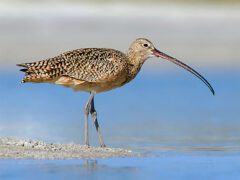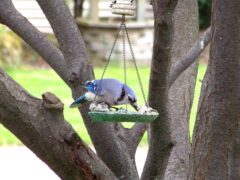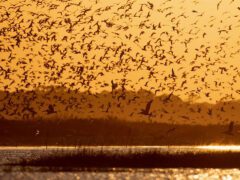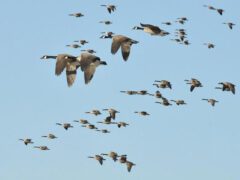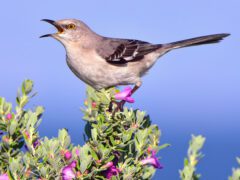White-rumped Sandpiper Similar Species Comparison
Main SpeciesWhite-rumped Sandpiper
Breeding adult
Medium-sized grayish shorebird with a white eyebrow on its finely streaked head. Wingtips extend beyond the tail when at rest.
© Jay McGowan / Macaulay LibraryNew York, May 18, 2020Juvenile
Juveniles look like adults, but have chestnut fringed feathers on their backs. Note the white eyebrow on the finely streaked head.
© Samuel Paul Galick / Macaulay LibraryNew Jersey, October 16, 2014Adult
Long wings that come to a point past the end of the tail impart a streamlined look. At distance bill can look all dark.
© Benjamin Clock / Macaulay LibraryNew York, September 03, 2011Juvenile
Juveniles often have brighter chestnut fringed feathers on the back than adults.
© Luke Seitz / Macaulay LibraryMaine, October 25, 2009Molting adult
On migration and during winter found in grassy marshes, mudflats, sandy beaches, flooded fields, and shores of ponds and lakes.
© Annie Lavoie / Macaulay LibraryQuebec, September 12, 2019Juvenile
The namesake white rump is visible in flight and sets it apart from other small sandpipers.
© Patrice St-Pierre / Macaulay LibraryQuebec, October 25, 2020Juvenile
Medium-sized sandpiper with wings that extend beyond the tail.
© Daniel Irons / Macaulay LibraryNew Jersey, October 12, 2019Breeding adult
Medium-sized grayish shorebird. Breeding adults have streaked flanks and a white eyebrow. The bill is black with a small amount of reddish orange at the base that is present in all ages, but the color can be difficult to see.
© Ian Davies / Macaulay LibraryAlaska, June 07, 2013Similar SpeciesBaird's Sandpiper
Juvenile
Baird's Sandpipers are usually browner with a more scaly back pattern than White-rumped Sandpipers. The wingtips on Baird's extend farther past the end of the tail than they do on White-rumped Sandpiper.
© Dorian Anderson / Macaulay LibraryMassachusetts, August 17, 2013Similar SpeciesBaird's Sandpiper
Nonbreeding adult
Baird's do not flash a white rump in flight like White-rumped Sandpipers and tend to be browner overall.
© Ian Davies / Macaulay LibraryOruro, August 22, 2013Similar SpeciesDunlin
Nonbreeding adult
Dunlins are larger with a more pronounced downward curve in the bill than White-rumped Sandpipers. On nonbreeding birds, the eyebrow stripe is not as obvious on Dunlins as it is on White-rumped Sandpipers.
© Alix d'Entremont / Macaulay LibraryNova Scotia, October 12, 2014Similar SpeciesWestern Sandpiper
Breeding adult
Western Sandpipers are smaller than White-rumped Sandpipers. Breeding birds have a rusty cap that neither breeding or nonbreeding White-rumped Sandpipers have.
© Thomas Barbin / Macaulay LibraryBritish Columbia, May 09, 2017Similar SpeciesWestern Sandpiper
Nonbreeding adult
Western Sandpipers are smaller than White-rumped Sandpipers and do not flash white in the tail like White-rumps do in flight. Nonbreeding birds have a whiter breast than nonbreeding White-rumped Sandpipers.
© Patrick Maurice / Macaulay LibraryFlorida, November 06, 2016Similar SpeciesLeast Sandpiper
Breeding adult
Least Sandpipers are smaller than White-rumped Sandpipers with yellow (not dark) legs. They also do not flash white in the tail like White-rumps do in flight.
© Evan Lipton / Macaulay LibraryMassachusetts, May 19, 2016Similar SpeciesLeast Sandpiper
Nonbreeding adult
Least Sandpipers are smaller than White-rumped Sandpipers with yellow (not dark) legs. They also do not flash white in the tail like White-rumps do in flight.
© Ian Davies / Macaulay LibraryGeorgia, September 28, 2016Similar SpeciesSemipalmated Sandpiper
Nonbreeding adult
Semipalmated Sandpipers are smaller than White-rumped Sandpipers. Nonbreeding Semipalmated Sandpipers have less streaking on the flanks than breeding White-rumps and a less obvious eyebrow than nonbreeding White-rumps.
© Jonathan Eckerson / Macaulay LibraryMassachusetts, July 16, 2017Similar SpeciesSemipalmated Sandpiper
Breeding adult
Semipalmated Sandpipers are smaller than White-rumped Sandpipers. Breeding birds have less streaking on the flanks than breeding White-rumps.
© Davey Walters / Macaulay LibraryMassachusetts, June 03, 2015Compare with Similar Species
Click on an image to compare
Species in This Family
Sandpipers and Allies(Order: Charadriiformes, Family: Scolopacidae)
More to Read
Don't miss a thing! Join our email list
The Cornell Lab will send you updates about birds,
birding, and opportunities to help bird conservation.




































